Jump to: Types of Error Coins | Most Valuable Penny Errors | History of the Lincoln Cent | Collecting | FAQs
Penny Error Coins Worth Money
Coin collecting as a hobby can offer plenty of options from which to choose. Pennies, for example, are a popular choice among collectors. Factors such as their affordability and long history in U.S coinage can help significantly.
However, one exciting aspect for collectors includes looking for errors in coins. The Lincoln penny, for instance, is also popular in this category. Since its inception in 1909 by the United States Mint, this 1-cent coin reached billions of examples minted throughout the years.
On top of that, the Lincoln cent went through changes in its metal composition. The U.S Mint has produced pennies made of different metals ever since its inception, and specific transitional errors have become more valuable.

If you want to collect these error coins and wonder what types of penny errors to look for, we have you covered. In this article, we will look at the most valuable errors in pennies, from the more common to the rarest examples.
In addition, should you be interested in how much are error pennies worth, look no further. We will provide an estimated value for these coins according to the most renowned coin grading services in the country and records from auction houses.
Types of Error Pennies
First, it is essential to understand the differences between the many known types of coin errors. The U.S Mint produces millions of examples every year and has made tens of billions of coins throughout its extensive history.
Mint employees identify most mint errors before the coin ever leaves the facility. Such faulty examples get destroyed, and their source material gets reused in new coins.
However, sometimes wrong planchet errors may pass unnoticed. A keen eye may realize their numismatic potential should these coins get into circulation.
On top of that, collectors interested in error pennies must be aware of the magnitude of the error, the coin’s overall condition, and scarcity.
As you will see on the following list of errors, these factors greatly influence how much an error penny is worth. It goes:
Doubled Die
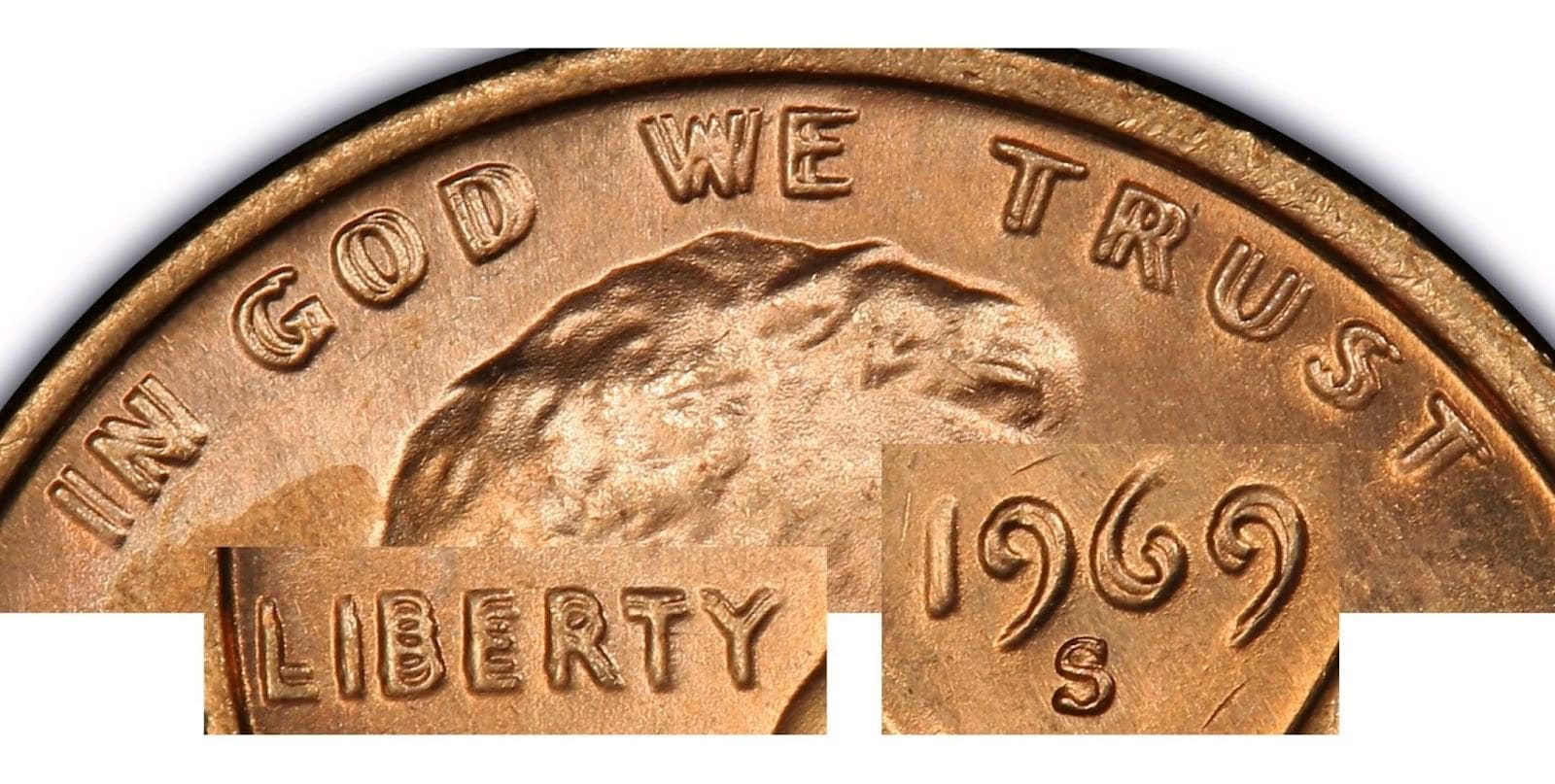
1969-S Doubled Die Lincoln Cent
A double die is one of the most common errors in coins. However, certain rare cases of this die error are so desired in the numismatic world that they have fetched extremely high prices in auctions throughout the years. Some of the world’s rarest coins feature this type of error.
A coin die is a metal stamping tool with a negative image of a specific coin’s design on its surface. A coin hub is a piece responsible for stamping the reversed image on the dies.
The term doubled die refers to an error that can occur during the die hubbing process. On rare occasions, a die may be stamped twice by a coin hub, resulting in two identical images slightly offset on the coin’s surface. Hence the name doubled dies.
Penny planchets stamped by doubled dies show a doubling in one of its verses. Most cases are evident through the use of a magnifying glass. Their prices vary according to how drastic the doubling looks along with the coin’s condition and scarcity.
Common examples, such as the 1995 1-cent coin, were auctioned for $65 in 2021 in MS65 conditions. On the other hand, an example of a 1969-S penny sold for $49,200 in 2022, in MS64 condition.
Die Cap Pennies
The error type known as die cap happens when a penny gets stuck to a die during the stamping process.
If the penny gets jammed in the coining press, it will receive successive strikes. The resulting coin eventually forms a “cap” either on the upper or lower die, similar to a bottle cap.
The other verse of the penny tends to get flat, with fading details of its design. Examples of these valuable pennies are scarcer than others and can be sold for hundreds of U.S dollars.
Off-center Pennies
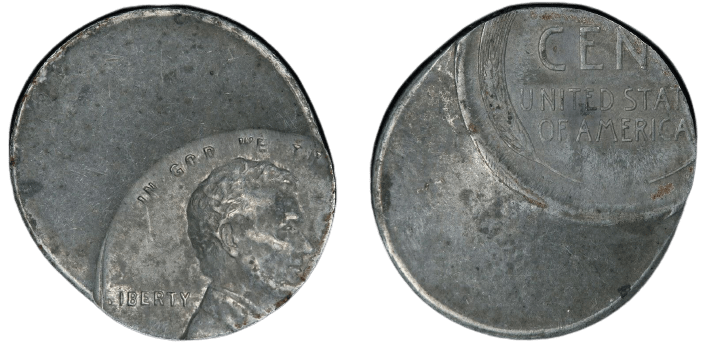
If a penny is not in the correct position between the dies during the stamping process, it may get struck off-centered.
Coins featuring this type of error have part of their design missing. Or, in other words, not having the center of the design matching the center of the planchet.
Coin grading services usually describe these coins with the percentage of the missing design. By doing so, they indicate how much of the blank planchet is visible and how drastic the error is.
Like all error coins, the value of this type of error cent varies. The most important factors include how much of its details are off-centered and how rare is that variant of the coin.
Pennies that have 40 to 60% of their design off-centered are considered a sweet spot by collectors since part of their design is still visible enough to identify the coin.
If the misplacing of the design is on the sweet spot, and if the coin is in overall good condition, these error pennies may vary from tens of dollars up to hundreds.
Blank Planchet Penny
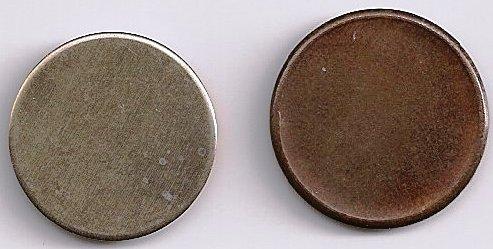
Should a planchet - the round piece of the source metal that gets stamped by the coin dies - by some means miss the stamping of the dies, a penny will have no design on its verses.
A blank planchet penny is an error piece often divided into two types: a blank coin with no visible rim and a blank planchet with a raised outer edge.
These types of strike errors are relatively common. Their value varies according to their source metal and if they have a raised rim. Prices can go somewhere between a couple of dollars to $29.
Broadstrike Pennies
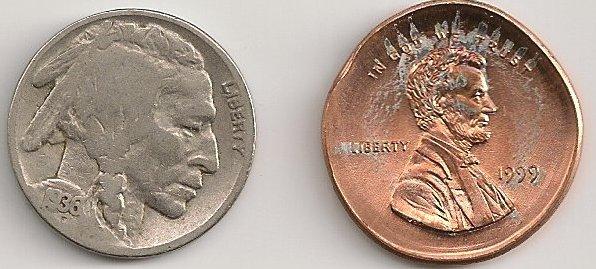
Broad-struck pennies have a larger diameter than usual. This type of error coin results from a mistake in the striking process when the pennies are struck outside the retaining collar.
When this happens, the collar does not retain the flow of the metal during striking. It results in an expansion of the coin’s diameter, making it look flatter.
The design of these error Lincoln cents is still visible on both sides. Broad-struck pennies may be worth $9 to $25, depending on how wide and apparent their error looks.
Clipped Planchet Pennies
As previously mentioned, pennies are struck from metal planchets from a specific strip of their source metal.
However, an error may occur in the process of cutting blank discs from the original sheet of metal. The resulting discs, or clipped planchets, have a characteristic shape, most commonly featuring a crescent-like cut on their edges.
This type of mint error is popular among collectors. Some coins containing this error can range from $14 to $20, and they may reach higher numbers according to the clipped percentage and the coin’s condition.
BIE Error Pennies
After striking many coins for an extended period, a coin die may begin to show cracks. After a while, these die breaks may begin to protuberate as raised spots on the surface relief.
The Lincoln penny dies, in particular, are commonly known for displaying die cracks resembling the letter “I” on the obverse die. This characteristic marking appears between the letters “B” and “E” on the word LIBERTY.
This Lincoln penny received the nickname “BIE” penny. One-cent coins struck from die cracks are very common and popular among collectors. An example with this striking error may be worth $5 up to $25.
Die Clash Pennies
A penny struck between two different coin dies: one housing the obverse imprint and the other the reverse.
However, a complication in the machinery that feeds the blank planchets to the dies can occur. When such happens, no blank penny is there to be struck, resulting in the clash of one die against the other.
As a result of this clash, once other blanks are fed into the dies, the design on the penny verses may show alterations. The reverse of the coin may display features of the obverse and vice-versa.
Lincoln pennies featuring mild die clashes are valued between $2 to $8. Error pennies with prominent clashes are worth $50 or more.
Re-punched Mint mark
Mint marks are a visual representation stamped into coins representing which U.S Mint facility minted the piece in question. They are tiny letters with the facilities’ initials: “P”, for Philadelphia Mint, “D” for Denver, “W” for West Point, and “S” for San Francisco.
For instance, the mint mark on the Lincoln cents is under the coin’s date.
Until the 90s, the U.S Mint used to hand punch the mint marks onto each coin die. Such manual labor involved slight variations in the marks’ placements.
Yet, eventual mistakes required the process to be redone. Repunched mint marks are reasonably common on pennies, given the many coins produced over the years.
This type of error coin is hugely popular among collectors. Repunched mint mark, or RPM pennies, are valued at about $5 or more, given that they’re commonly available.
Filled Die

In some specific cases, so-called mint grease may interfere in the dies’ process of striking blank planchets.
This grease, which consists of a combination of dirt, metal, and oil, can gather around the area of the mint mark. After gradually filling up the die markings, the grease can affect how defined the impressed details are. Filled die errors, such as this one, can produce valuable error coins.
Different levels of “strength” are a result of this process. Weaker or close to no mint marks occur when the grease fills most of the die relief.
These error Lincoln cents are worth anywhere from $17 to $528 in circulated conditions, with key dates such as 1922 fetching higher auction prices.
Transitional Error Pennies
Throughout the Lincoln penny’s century-long history, there have been specific changes to the coin’s design or metal composition.
These changes led to errors such as striking the wrong date on a specific planchet or even a penny getting struck on a dime planchet.
Transitional error pennies include some of the most valuable pennies out there. Some famous examples can reach over a hundred thousand dollars.
To put matters into perspective, let’s look at a few of the most valuable error pennies.
Most Valuable Error Pennies
1922-D No “D”

Contrary to 1922-D Lincoln cents bearing a weak mintmark due to the buildup of grease, this variety is believed to result from a filing of the coin dies.
After a clash of the dies responsible for striking regular 1922-D cents, there was visible damage to their impressed images. While the reverse die got replaced by a newer one, it is said that a mint employee filed the obverse die and accidentally removed the “D” Denver Mint mark.
The 1922-D No “D” cent is considered one of the most valuable wheat pennies. According to its auction history, this coin values from $329 and reaches up to $82,250.
1944 Steel Penny

During WW2, the U.S war effort required copper to manufacture ammunition. For this reason, the year 1943 saw a change in the metal composition of the Lincoln cent. The copper content was briefly replaced by steel until the mint reversed it back to copper in 1944.
An extremely rare batch of 1944 pennies was produced using the previous steel planchets. There are very few coins featuring this rare error.
These planchets are believed to either be from the earlier 1943 steel penny batch or from a steel blank meant for a foreign coin that accidentally fell with the bronze blanks.
At any rate, this wrong planchet error piece has reached between $5,875 and $180,000 in auctions.
1969-S Doubled Die Obverse
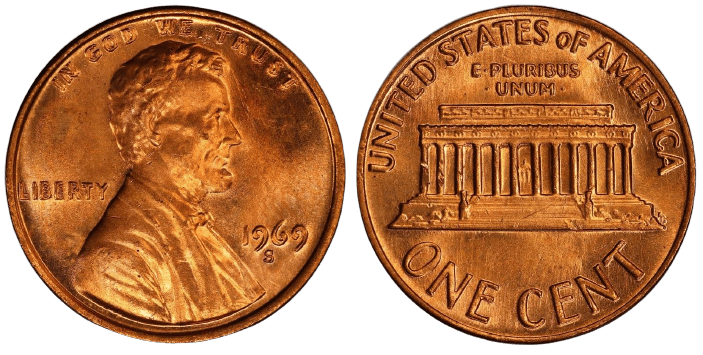
The 1969-S Doubled Die variety is among the most notorious mint error coins, primarily because it was considered a counterfeit long before the discovery of a genuine example.
In the late 60s and early 70s, the 1969 Lincoln cent acquired notoriety due to a counterfeiting scheme that broke the news. Following the fake coins apprehension, many original doubled die examples got destroyed along with the counterfeits.
The increased scarcity, along with the buzz surrounding this date made the 1969-S Doubled Die penny a prominent variety among coin collectors.
There are few known examples, and auction prices range from $16,500 to $126,500.
History of the Lincoln Penny
Inception
The 1-cent coin, or penny, is one of the oldest coin denominations in U.S coinage. It was introduced through the Coinage Act of 1792, a determining point in establishing the U.S dollar and creating a national minting facility, the United States Mint.
The penny has had plenty of designs throughout its more than 200-year run. However, no obverse design lasted as long as the Lincoln portrait.
The US Mint introduced the Lincoln cent coin in 1909. It succeeded the Indian Head penny, a design that circulated for 50 years and is considered a favorite and highly-sought coin.
Designs
Sculptor Victor David Brenner designed the original Lincoln obverse. The artist was also responsible for the Lincoln penny’s first obverse, featuring two stalks of wheat.
There have been different reverses for the Lincoln cent over the years. The wheat obverse mentioned above circulated from 1909 to 1959. These coins are nicknamed wheat pennies.
From 1959 until 2008, the one-cent coin featured the Lincoln Memorial design, envisioned by engraver Frank Gasparro.
In 2009, the penny received four different designs to celebrate Abraham Lincoln's bicentennial. The obverse images were a symbolic representation of the late President’s early years in Kentucky and Indiana, professional life in Illinois, and his presidency in Washington, DC.
In 2010, the Lincoln cent received its latest design, created by Lyndall Bass and sculpted by Joseph Menna. It portrays a Union Shield with the national motto and the coin’s face value. The Shield obverse design is currently in circulation in all U.S territories.
Collecting Penny Error Coins
The world of coin collecting and numismatics offers many routes of interest. Collecting and even making some money on error coins, such as pennies, is an increasingly popular habit among coin enthusiasts.
You always have the chance to be carrying error pennies on your pocket change. The U.S Mint produces billions of coins each year, and as we’ve seen in this article, some minting errors do manage to leave the mint.
Some types may be rarer than others, but one thing is for sure: there are still error coins out there waiting to be found. We hope this article helped showcase different penny errors and how to spot them.
FAQs
How Much Is An Error Penny Worth?
The value of an error cent varies according to factors such as how drastic the error is, the type of error, the scarcity of the coin, and its condition.
Common error coins sell for around $2 to $50. Examples such as the 1943 Bronze Lincoln Penny are extremely rare, with only one known piece. It has an estimated value of $164,500.
What Year Error Pennies Are Worth Money?
Error pennies can occur on virtually any year of mintage. The value of an error coin is determined by how drastic the error is, its scarcity, and overall condition.
Error coins like the 1944 Steel Penny are very valuable since very few known examples were struck using the wrong metal planchet.
What Is An Error Penny?
A penny, or one-cent coin, with an error during the striking process is called an error penny. These errors can be related to the coin die, resulting in doubled die, die crack, and die clash pennies.
They may also occur if the coin planchet is not in the correct position or if the machine is fed an incorrect metal planchet.
















